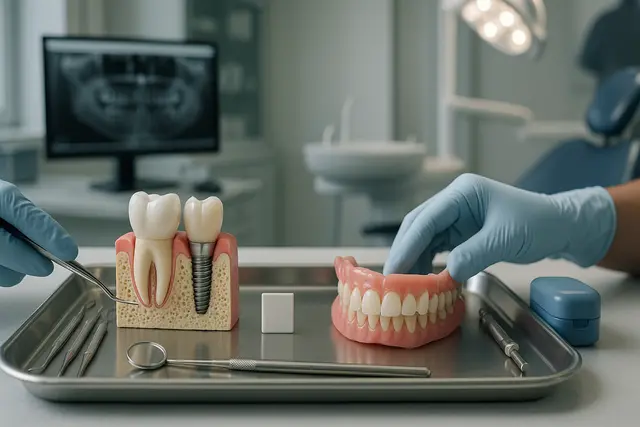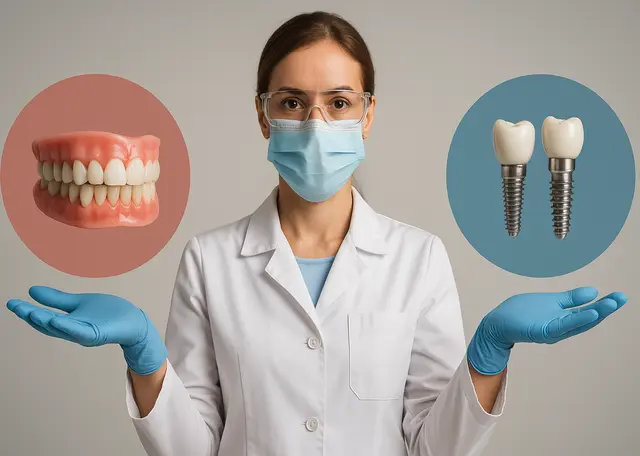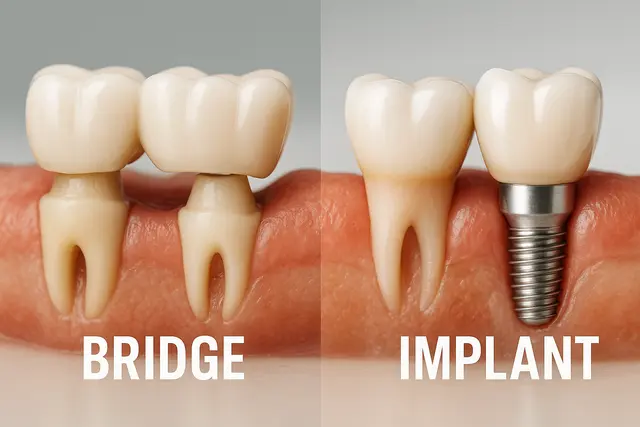Prosthodontics
7 min read
Jun 02, 2025
Snap-In Dentures Before and After: What to Expect From Your New Smile
If you’ve been living with uncomfortable, loose-fitting dentures, or missing teeth that keep you from smiling fully, snap-in dentures might be the life-changing solution you didn’t know you needed.

There’s nothing quite like the moment someone sees their new smile in the mirror for the first time. Relief. Confidence. Maybe even a few happy tears. If you’re considering snap-in dentures, chances are you’ve lived with missing teeth or an ill-fitting denture for a while. And you’re more than ready for something better, something that feels secure, looks real, and lets you eat more than soup and mashed potatoes. Good news: snap-in dentures are the upgrade your mouth’s been waiting for.
Let’s walk through what to expect before and after getting a snap-in denture, without sugarcoating anything. Just real talk, from dental pros who’ve helped a lot of people like you snap their confidence back into place.
The Denture Struggle Is Real
If you’ve ever worn traditional dentures, you know the drill. They can shift when you talk. They wiggle when you eat. Adhesives become your best frenemy. And don’t even get us started on the awkward clicks or that feeling they might slip out at the worst moment. Even if they look okay on the outside, the inside story is usually one of frustration.
That’s where snap-in dentures step in and say, “Enough.”
What Makes a Snap-In Denture Different
Here’s the gist: snap-in dentures (also called implant-retained dentures or snap-on dentures) are secured by dental implants placed into your jawbone. These implants act like sturdy anchors. Your denture has special fittings underneath that “snap” onto those anchors, so they stay put. We’re talking real security, not wishful thinking and denture glue.
Unlike traditional dentures that just sit on your gums, snap-in dentures are held in by dental implants. That means you can chew with much greater power and confidence. Say hello to apples, steak, and crunchy tacos. Your smile will look natural, but the real game-changer is how much better your dentures feel.
The Basics of an Implant Denture
Snap-in dentures are essentially dentures with special fittings that attach to titanium implants placed in your jaw. These implants are typically not visible, and once healed, they make your dentures truly stable.
An implant denture requires at least two implants for the lower jaw, though four dental implants is usually much better than two. A lower implant denture requires those implants to be placed strategically to handle chewing forces and help your dentures fit and feel better.
For the upper jaw, snap-in dentures may involve more implants and sometimes having part of their upper denture’s palate removed for improved comfort and taste sensation. Imagine biting into an ice cream cone and actually tasting it again, that’s the kind of upgrade we’re talking about.
Snap-In Implant Dentures vs Traditional Dentures
Let’s call it like it is. Traditional dentures typically look nice, but they don’t always behave. They rely on suction, a tight fit, and sometimes adhesives to stay in place. Over time, bone loss makes them looser. That’s because without tooth roots or implants, the jawbone begins to shrink.
Snap-in implant dentures, on the other hand, are supported by dental implants. That stimulation helps preserve the bone, so your face maintains its natural shape longer. Plus, snap-in dentures offer a more secure and comfortable fit than traditional dentures ever could.
The Benefits of Snap-In Dentures
People love these for a reason. Here are just a few real-life benefits of snap-in dentures:
Snap-in dentures provide amazing stability. You’ll chew, talk, laugh, and sneeze without worrying they’ll pop out.
They help your face maintain its natural contours because the implants preserve bone.
Cleaning is easier than you’d think. Just remove them 1–2 times per day and brush gently with a soft dental brush.
They look like natural teeth. No one will know you’re wearing a denture.
You’ll be able to chew with much greater power and confidence than with removable dentures.
The comfort of your dentures. Because they’re secured in place, there’s no more sore spots from rocking or sliding.
Understanding the Dentures Procedure
The dentures procedure for snap-ins involves a few steps, but each one brings you closer to your new smile. First, any remaining teeth are removed. Then, your dentist will place the implants, usually titanium implants, which have been around for decades and are biocompatible (your body won’t reject them).
After the dental implant procedure, you’ll need time to heal. Implants and place small healing caps are part of that process, and you may wear a temporary denture during this phase. This isn’t just about waiting, it’s about letting the bone and implants bond securely. That healing period makes your implants truly stable.
Once your gums have healed and the implants are strong enough, your dentist will finish your snap-in dentures and attach the fittings that connect them to your implants. Then comes the best part: you snap them back in and see your new smile.
The Question Everyone Asks: Will Food Get Under My Implant Denture?
Here’s the honest answer: sometimes, yes. Even the best-fitting implant denture isn’t totally sealed off. But here’s the key difference, because they’re removable implant dentures, you can pop them out and clean them thoroughly. That makes a world of difference in keeping your gums and dentures clean and healthy.
If you ever feel something stuck under your snap-in denture, just snap it out, rinse, and snap it back in. Way easier than dealing with adhesives and slippage.
How Many Implants Do I Really Need?
This depends on your dental needs, but most lower implant dentures require at least 2 implants. For better function and longevity, 4 implants in the lower jaw is common. Upper dentures might require more. Your dental professional will guide you based on your bone health and goals.
Remember: while securing your denture with dental implants is a bit of an investment, it pays off in quality of life. It’s permanent dental peace of mind.
Implant Inserts Need Maintenance Too
Every now and then, you’ll need to change out the snap rings in your implant dentures. These little rings are what let the denture “click” onto the implant. Over time, they can wear out, especially if you snap your dentures in and out frequently. Your dentist can take care of this during regular dental check-ups.
Forget to clean your implants or avoid maintenance too long, and things can get uncomfortable. So yes, dentures still rock, but they do need some love and care.
Snap My Dentures or Glue Them Down?
Once you experience snap-in dentures, going back to traditional glue-and-go dentures feels like using a flip phone in a smartphone world. Snap-in dentures are much more secure than dentures that rely on adhesives. They don’t shift. They don’t fall out. And best of all, you can still take them out for easy cleaning. That’s the beauty of implant dentures removable by design.
Snap-On Dentures: A Close Cousin
People sometimes confuse snap-in with snap-on dentures. They’re similar, but snap-in dentures usually refer to dentures that snap onto implants, while snap-on dentures may refer to ones that fit over remaining natural teeth or existing dental structures. Either way, they’re both miles ahead of traditional options when it comes to staying power and comfort.
What About a Denture With Dental Implants on Just One Arch?
You don’t always have to do both upper and lower jaws. Some folks start with a lower snap-in denture because that’s where traditional dentures tend to feel the loosest. Others opt for a denture with dental implants on the upper jaw and keep a partial denture on the bottom. It’s flexible based on your dental issues and goals.
Candidates for Snap-In Dentures: Are You One?
Good news: many people are candidates for snap-in dentures. If you’ve lost teeth or struggled with traditional dentures, snap-in implant dentures could be the right next step. Your dentist will evaluate your jawbone, gum health, and medical history to see if you’re a fit.
And if you’re thinking, “I’ve had dentures for years, can I still do this?” The answer is often yes. Even if your bone has thinned, bone grafting or mini implants might still make it possible.
Before and After: What’s the Real Change Like?
Before and after: You may be struggling with loose dentures, avoiding social events, or skipping certain foods. Your mouth feels like it’s never truly your own.
After: You’re biting into your favorite meals again. You’re talking without adjusting your dentures mid-sentence. Your face looks fuller, and your smile? It’s finally something you love seeing in the mirror.
Dentures Over Traditional Dentures: The Verdict
Choosing snap-in dentures over traditional dentures isn’t just about looks. It’s about function. It’s about the confidence to laugh at a joke without covering your mouth. It’s the freedom to eat what you love, whenever you want. And it’s the peace of mind that your dentures are finally working with you, not against you.
Snap-in dentures involve some upfront planning, yes. But the payoff is a daily life that feels normal again, maybe even better than before.
If you’re ready to explore this option, talk to a trusted dental professional. Ask about implant dentures, removable implant dentures, and all the possibilities available for your unique dental care journey. Your best smile might just be one snap away.
How Do Snap-In Dentures Stay in Place?
Snap-in dentures are anchored by dental implants placed into your jawbone. These implants have special connectors that allow the denture to “snap” securely into place. Unlike traditional dentures that rely on suction or adhesive, snap-ins offer a much more stable and confident fit for speaking, eating, and smiling.
Are Snap-In Dentures Removable or Permanent?
Snap-in dentures are removable by design. While they stay firmly in place during daily use, you can (and should) take them out for cleaning. This makes hygiene easier and helps protect your gum health, while still offering a secure fit that feels nearly permanent when worn.
How Many Implants Are Needed for Snap-In Dentures?
Most lower snap-in dentures require at least two implants, though four is preferred for better stability. Upper snap-in dentures may need more due to bone density and anatomical structure. Your dentist will determine the ideal number based on your bone health and personal goals.
Do Snap-In Dentures Require Maintenance?
Yes, regular maintenance is essential. You’ll need to remove and clean the dentures daily, and your dentist will occasionally replace the snap-in components (like retention rings) as they wear out. Keeping up with dental check-ups also helps ensure your implants and gums stay healthy over time.
Read Next
Related Posts

Prosthodontics
Implant vs. Dentures Pros and Cons: A Deep Dive into Modern Solutions
Missing teeth can impact more than just your smile, they can affect how you eat, speak, and feel about yourself. Fortunately, modern dentistry offers two leading solutions to bring back both function and confidence: dentures and dental implants. Understanding the pros and cons of each can help you make the choice that fits your needs, lifestyle, and budget.
7 min read
Oct 17, 2025

Prosthodontics
Full Mouth Implants vs. Dentures: Which Is Better for You?
When it comes to replacing missing teeth, the choice between full mouth dental implants and dentures can be overwhelming. Each option has its own set of benefits, limitations, and long-term considerations, making it essential to understand what works best for your needs, health, and lifestyle.
5 min read
Oct 17, 2025

Prosthodontics
Tooth-Supported Bridge vs. Implant Comparison: Benefits, Drawbacks, and Insights
Deciding between a dental bridge and a dental implant can feel overwhelming, especially when both options promise to restore your smile and improve oral function. Each solution comes with its own set of benefits, considerations, and ideal use cases, making it essential to understand how they compare before choosing what’s right for you.
6 min read
Oct 17, 2025
Don’t have time to research every dentist around you?
See why 30k+ patients trusted us